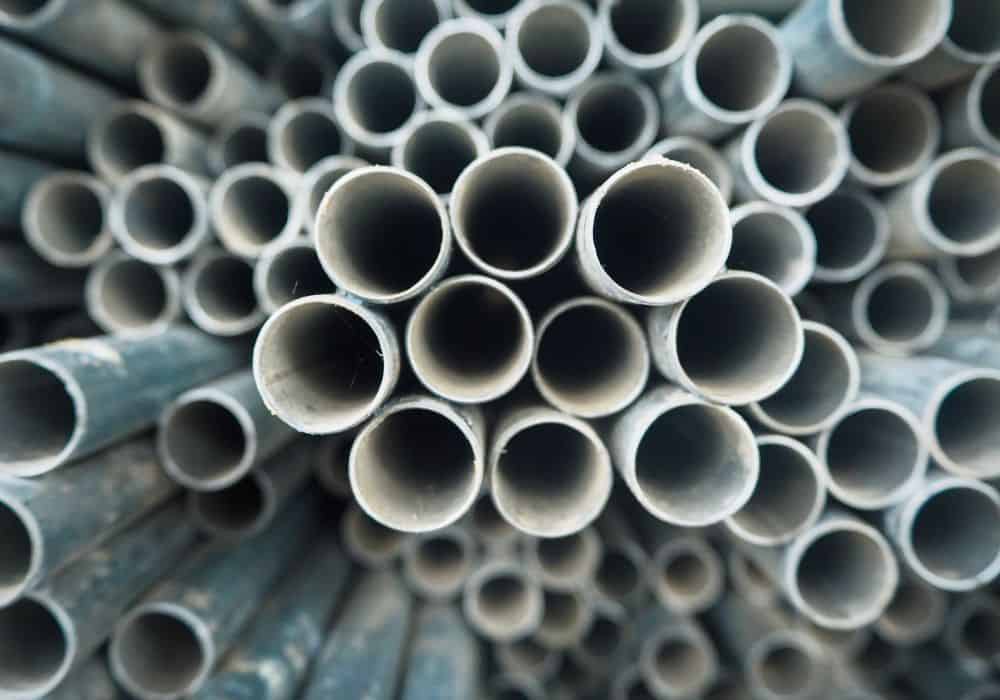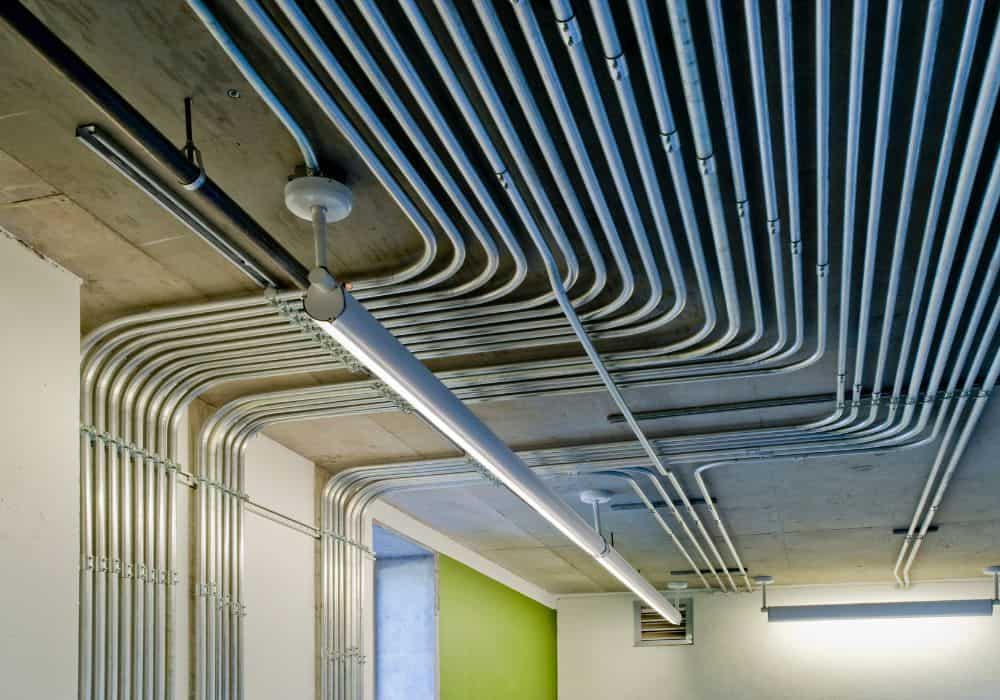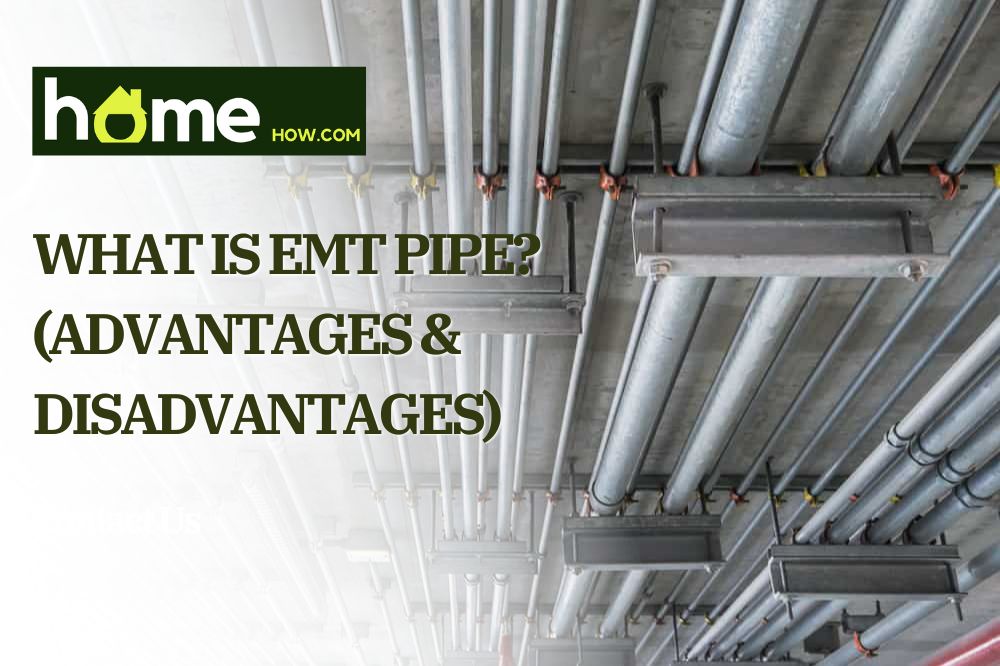Electrical metallic tubing, or an EMT, is a rigid metal conduit that can be made of many different metals but serves one core purpose – protecting and carrying essential wires throughout our homes.
They are usually found in spaces in exposed and concealed areas, making them ideal pipes for running through basements, attics, garages, and inside walls.
But like any pipe, when you lay an EMT down, you want to be able to secure it, forget about it, and allow it to do its work. And knowing all about it before you place one can help you avoid disaster.
In this article, we’re going to explore everything you need to know about EMT pipes. We’ll discuss how and where to place them and their core benefits. Ultimately, you can decide if EMT is the right choice.
What is a conduit? And why is it needed?
To appreciate why you need an EMT, you must first understand what a conduit pipe is and where you can find them.
Electrical conduits protect electrical wiring throughout a building and are valuable for routing it in different directions. MT pipes are highly efficient in securing wires indefinitely once you properly install them, and they have several advantages over other types of piping and methods of carrying wires.
The benefits of choosing EMT piping
Below we’ll go through several advantages of what makes an EMT a truly unique piping system:
1. EMT pipes are easy to install
Despite what people might think about working with metals, EMT pipes are perhaps one of the most straightforward systems to install. No matter your skill level, beginners and experts alike can expect quicker and easier setup than other materials.
For example, the above video shows how EMT piping provided a neater, more streamlined system than the MC cable material. Additionally, EMT pipes protected wires against balding or tearing and took up much less space than cabling.
2. EMT pipes have high physical and temperature thresholds
EMT pipes are often made of steel, stainless steel, or aluminum and, as such, has an impressive temperature range. This ensures that they protect wires from fire and explosions and will not act as a source of fuel for any stray blazes.
Additionally, as non-combustible conduits, EMT pipes can be used in various environments like gas stations and oil refineries more safely and securely. Their properties also make piercing them or breaking them from impact near impossible.
What’s more, EMT tubing also actively resists flattening, kinking, and splitting, in turn helping to create smoother continuous raceways for faster wire pulling.
3. EMT pipes are cheap and lightweight
Cost can be one of the deciding factors in how we pipe our homes and businesses. We want something that protects our electrical systems while not breaking the bank.
EMT pipes are commonly made of aluminum, which means they are cheap to buy but don’t compromise strength. Aluminum is also one of the lightest metals on the market, making it an attractive material to work with when directing wires across homes and industrial workplaces.
4. EMT pipes are versatile
They can be placed in the concrete, underground, or in areas prone to corrosive properties. A galvanized coating on the outside has corrosion resistance and protects both the pipe and its contents from outside chemicals. Couple that with the EMT’s accessible bending properties; you can fit them in virtually any crevice or space or bypass troublesome obstructions.
Additionally, EMT pipes protect wires from liquids like water and oil, as well as vibrations too. This makes the EMT piping suitable for going through concrete or underground. A corrosive-resistant organic coating on the interior surface ensures structural integrity.
5. Longevity
EMT pipes can be used repeatedly so long as they don’t suffer structural damage. Additionally, as a modern form of piping, they meet many different regulations and legalizations, meaning they’re an ideal choice for upgrading old houses and future-proofing DIY projects against future changes in the law.
This means that when you lay down EMT piping, you won’t have to back over your system to meet new demands. And if they need replacing for a reason, you can reuse the conduits in a unique setting, making them an environmentally friendly choice to consider.

6. Variety of sizes
Many manufacturers have set dimensions on their websites, detailing everything from weight, and trade size, to the nominal wall thickness and nominal outside diameter. EMT is available in standard trade sizes 1/2 through 4, 10′, and 20′ lengths.
Because they are often mass-produced, you will find a wide variety of different sizes to buy from. If you don’t find an EMT pipe that fits your job, you can easily cut them and smooth them over to your desired length.
7. EMT pipes come in a range of colors and accessories
Despite their metal base, EMT pipes can be easily coded by buying different colors from your retailer. You can quickly identify other wiring systems and plot their destination accordingly, separating them by color.
This means that you can easily spot which electrical circuit or wires needs examining at a future date. It also means you can reroute wires quickly if the position of sockets, circuits, or electrical equipment changes in your room.
8. Bending EMT Pipes
Despite being classed rigid, EMT pipes are still somewhat flexible, allowing experienced electricians to bend them. The above video showcases how practical it can be to bend your EMT pipes, so long as you correctly adhere to your measurements and offsets.
Disadvantages of EMT pipes
EMT pipes are not without their flaws, faults, and considerations. You should recognize some restrictions or reservations when considering them, though arguably, they have fewer than competing materials. The disadvantages of using EMT pipes can include the following:
1. Avoiding certain environments
There are certain restrictions on where you can place EMT piping. Avoid areas with high traffic or where there are lots of chemical fumes, as continuous exposure can negatively damage the structural integrity of the pipes.
Additionally, avoid cement – the alkalis will speed up the corrosion of rigid conduits like EMT and lead to exposed wires over time. This may limit EMT piping’s suitability in commercial buildings somewhat.
2. Flexibility
Although EMT pipes can be bent to fit snuggly around corners, they are not as flexible or malleable as competing materials like PVC conduit. Their plastic properties mean they can fit better in various complex and specific shapes, which can be more suited for intricate wiring.

3. Legislation
When installing EMT tubing, you must be in accordance with the National Electrical Code 2020 (NEC). While every material requires some following of a law, EMT pipes do have some specific technical requirements.
A licensed electrician can give you some guidance. But below, we’ve highlighted some of the key areas that you should be aware of:
- Bends:24 and 26 demand that you do not compromise the internal diameter of the EMT pipe when bending. You must also not have 360-degree bends from one point to the next. Any more, and you risk damaging the insulation inside.
- The support network:30 states that you must support EMT piping every 10-foot of pipe.
- Reaming required: 358.28 states that you must ream the ends of cut EMT pipes to ensure that they are smooth and easy to secure together. No threads except a factory-threaded integral coupling.
- Connectors: 358.42 states that couplings and connectors must be tightly fastened across the EMT system to prevent ground faults as a grounding conductor.
4. Additional skills may be required depending on the job
This is relative to the job you have at hand. EMT pipes are straightforward to place, secure, and practical to feed the wire through. But if you need to bend the pipes, this does require a certain degree of skill and expertise. Additionally, securing and supporting the pipes may require working with clamps and hangers, requiring some DIY skills.
Conclusion
EMT pipes prove to be invaluable protection for you and your home. Lightweight, cheap, and easy to install, EMT pipes provide a straightforward, easy way to safeguard your electrics.
EMT pipes have several benefits that make them the preferred choice over plastics and other types of conduits. Laying them is quick, easy, and practical, and rerouting wires within them is straightforward. And even if you need to adjust your circuit, replacing and repositioning them is foolproof.
All you need to do is plan your route, secure your pipes correctly, and ensure you always protect the wire. But if you still have any questions about EMT pipes or tips of your own to share, make sure to leave a comment below.
The main thing to remember about EMT pipes is:
- EMT pipes have a massive advantage over PVC in that they don’t require grounding
- Use conduit hangers or clamps to attach EMT pipes securely to walls and ceilings
- It’s always better to push the wire through an EMT pipe than pull
- Despite their metal structure, bender handles should be able to correct any improper bends throughout your system.
